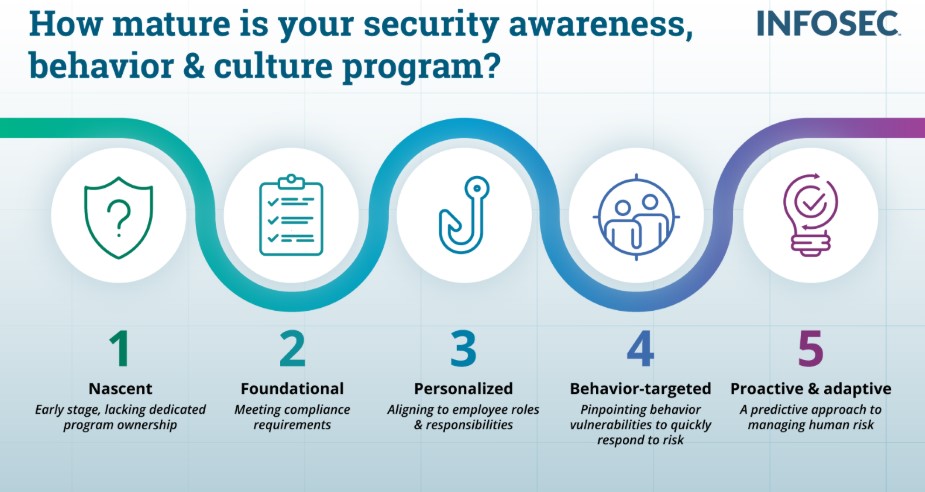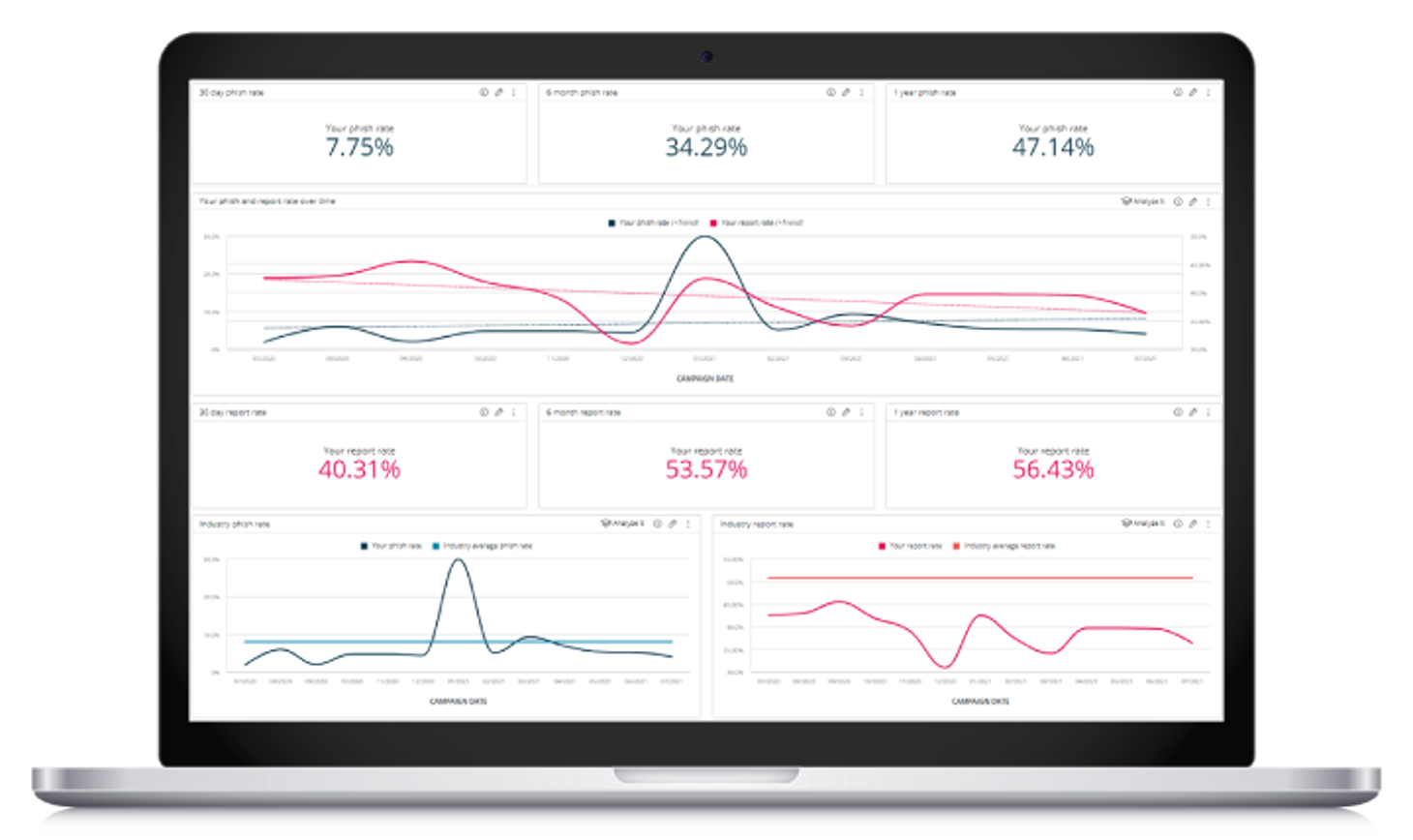You've been told you need a security awareness program. Now what?
You've just been told you need to create a security awareness program. Whether this directive came from compliance requirements, followed a cyber incident or emerged from a risk assessment, you might be wondering where to start — especially if this is being added to your already full workload.
Take a deep breath. Starting a security awareness program doesn't mean you need to build everything from scratch or figure it out alone. Many organizations face the same challenge, and there are proven approaches and resources to help you succeed.
Think of building a security awareness program, like setting up a new fitness routine. You don't need to run a marathon on day one. Start with where you are, establish your baseline and make steady progress toward your goals.
Let's break down the essential steps to get your program up and running.
In this guide:
- Understand why a security awareness program is essential
- Define your goals and audience
- Select the right tools and resources
- Launch and promote your program effectively
- Measure success and continuously improve
Understand why a security awareness program is essential
If you're in charge of rolling out security awareness training, you're probably dealing with one or more key drivers. Most commonly, organizations need a program to meet compliance requirements. Key regulations like GDPR, HIPAA, PCI DSS and CMMC 2.0 mandate regular security training for staff who handle sensitive data.
For example, if your organization accepts credit card payments, PCI DSS requires you to train employees on security policies and procedures at least annually. Healthcare providers under HIPAA must provide regular security training to all staff members interacting with patient data.

Relatable workers learn to stay secure at work and at home in the Infosec IQ Need to Know series covering NIST recommended topics. See the full training library here.
ISO 27001 certification represents another common driver. This globally recognized framework helps organizations meet various data protection requirements while reducing the frequency of audits. The standard requires organizations to ensure employees receive appropriate security awareness education and training.
Beyond compliance, many organizations launch security awareness programs after experiencing a security incident. If this describes your situation, you're not alone. According to IBM's Cost of a Data Breach Report, organizations lacking security awareness training face breach costs averaging $1.39 million more than those with comprehensive training programs.
The math makes sense when you consider that 68% of breaches involve human actions like falling for social engineering attacks or making security mistakes. Without proper training, employees can unintentionally expose organizations to phishing, credential theft or ransomware.
Building an effective program means going beyond basic compliance requirements.
Your training should equip employees with practical skills through engaging content like:
- Interactive courses mapped to real-world scenarios
- Video-based training that shows security best practices
- Hands-on exercises that reinforce key concepts
- Regular phishing simulations to practice threat identification
- Visual aids like posters to keep security top of mind
Define your goals and audience

Every organization is at a different level of security awareness maturity. Download our full Security awareness maturity infographic to learn more.
Security awareness is an ongoing journey, and it's perfectly fine to start at the beginning. Your goals will naturally evolve as your program matures, and every organization's path looks different based on its unique risks and needs.
Start by assessing your current cybersecurity culture to identify your biggest gaps. Tools like Infosec's free Cybersecurity Culture Survey can measure employee attitudes and perceptions toward security. A free Phishing Risk Assessment provides concrete data about your organization's susceptibility to phishing attacks.
With your baseline established, set clear objectives based on your primary drivers. If compliance drives your program, focus on meeting regulatory training requirements.
Organizations concerned about phishing should emphasize simulation-based training. The key is matching your program goals to your organization's specific needs and risks.
Role-based training forms a crucial part of your strategy. While all employees need basic security awareness education, certain positions require specialized focus. Your HR team faces unique risks around handling sensitive personnel data and avoiding targeted spearphishing attacks.
IT administrators need deep training on access controls and system security. Finance teams should focus heavily on business email compromise scams and safe payment verification procedures.
Strengthen security awareness with human risk management
Infosec HRM, powered by Right-Hand Cybersecurity, provides alert-based training nudges to minimize human risk at your organization. 
Consider these factors when planning role-based training:
- Job function and access to sensitive data
- Department-specific security policies
- Common attack scenarios for each role
- Regulatory requirements by position
- Technical skill levels
Your training frequency should align with both risk levels and operational needs. New hires need comprehensive onboarding about security expectations. High-risk roles might require monthly updates, while annual refreshers might suffice for lower-risk positions.
Build your schedule around:
- New hire orientation requirements
- Compliance deadlines
- Seasonal security risks
- Major system or policy changes
- Industry threat trends
Remember that different teams have varying schedules and learning preferences. Sales teams might prefer short, mobile-friendly modules they can complete between client meetings. IT staff might benefit from more technical, hands-on training sessions. Customer service representatives might need focused training on protecting customer data during support interactions.
Monitor your program metrics to ensure you meet objectives and adjust your approach based on results. Regular assessment helps you refine your goals and ensure your program grows alongside your organization's security needs.
Phishing simulations & training
![]()
Select the right tools and resources
Building an effective awareness program requires tools to deliver training, measure behavior and track progress. The right tools will help you inform training decisions and report progress to stakeholders while making your job manageable.
Explore comprehensive training platforms like Infosec IQ that offer features like phishing simulations, pre-built and customizable training plans and compliance tracking. When evaluating platforms, think beyond basic course delivery. Modern security awareness platforms should provide rich features that engage learners and make program management efficient.
Training content management forms a crucial piece of your toolkit. Your platform should provide a library of up-to-date security awareness modules that stay current with evolving threats. Role-based learning paths ensure different job functions receive relevant training, while interactive scenarios keep learners engaged. Mobile-friendly content and multi-language support have become essential for today's hybrid workforce.

Many modern training platforms offer automations and integrations with your existing security, training and business tools, from identity management to single sign-on.
The administrative burden of running a security awareness program can be significant without the right tools. Look for automation features like self-service enrollment, automated reminders, HR system integration and bulk user management capabilities.
You don't need to create everything from scratch. Take advantage of free resources to supplement your program. Visual aids like security awareness posters can reinforce training messages in office and remote work environments. Seasonal training kits help you address current threats, while newsletter templates keep security top of mind between formal training sessions.
Framework alignment plays a vital role in program success. Choose platforms that support industry-specific compliance standards and align with established guidelines like the NIST Cybersecurity Framework.
Comprehensive reporting features help you demonstrate value and identify areas needing attention. Track completion rates across your organization, measure phishing simulation results and monitor behavior changes after training. Strong reporting tools also simplify compliance documentation and create executive summaries that communicate program impact to leadership.
Launch and promote your program effectively
A successful security awareness program needs clear communication and steady engagement. Your launch strategy should explain not just what employees need to do but why security matters to them and the organization.
Start by putting the program in context. Help employees understand the stakes — the average data breach costs organizations $4.45 million, according to IBM. But avoid fear tactics. Instead, focus on empowering employees to be part of the solution. Explain how their actions directly contribute to protecting customer data, intellectual property and business operations.
Before rolling out training widely, establish your baseline metrics. As we mentioned earlier, it is best to run initial phishing simulations to understand current awareness levels. This gives you concrete data to show improvement as your program progresses.
Consider a phased rollout approach based on your organization's needs:
Phase 1: Key departments
- Start with high-risk teams like IT and HR
- Gather feedback and refine materials
- Document early wins and lessons learned
- Build internal champions for wider rollout
Phase 2: Department-specific training
- Customize content for each department's risks
- Address unique compliance requirements
- Include relevant examples for each team
- Provide role-specific security guidelines
Phase 3: Organization-wide implementation
- Launch company-wide baseline training
- Deploy regular phishing simulations
- Establish ongoing awareness campaigns
- Monitor completion rates and engagement
Keep security visible through multiple channels:
- Regular security newsletters with current threats and tips
- Digital signage or posters in common areas
- Updates in team meetings and town halls
- Recognition for security-conscious behavior

Supplementing training with posters and digital banners in your newsletters reinforces cybersecurity best practices.
Make training engaging through gamification elements. Create a friendly competition between departments for phishing awareness scores. Recognize individuals who consistently spot and report suspicious emails. Consider rewards for teams that maintain high training completion rates.
Support continuous learning with a training content library that employees can access on-demand. Include quick reference guides, video tutorials and interactive modules covering various security topics. This empowers employees to refresh their knowledge when they need it most.
Keep the momentum going with regular communication touchpoints:
- Monthly security tips aligned with current threats
- Quick video updates about emerging risks
- Success stories from your organization
- Practical security reminders for home and work
Remember that building security awareness is a gradual process. Focus on steady progress rather than perfection, and celebrate improvements as your program matures.
Measure success and continuously improve

Use pre-built dashboards to prove compliance, share progress with stakeholders and detect risk before a breach occurs.
Effective measurement helps you demonstrate your program value and identify areas for improvement. Use analytics and reporting tools to track key metrics that matter to your organization.
Start by monitoring basic completion metrics:
- Training completion rates by department
- Phishing simulation results
- Policy acknowledgment status
- Assessment scores
- Incident reporting rates
But don't stop there. Dig deeper into behavioral changes that indicate real security improvement. For example, after establishing your baseline phishing susceptibility rate, track how employee response to simulated attacks changes over time.
Look for trends like:
- Decreased click rates on phishing simulations
- Increased reporting of suspicious emails
- Faster response times to security incidents
- Reduced policy violations
- Better password hygiene
- Reduced SOC alerts
Organizations typically see significant improvements after implementing comprehensive awareness programs. For instance, after Amway partnered with Infosec to boost the security awareness of their 18,000 employees, they experienced a 20% drop in their phishing rate and a 30% decrease in malware infected machines.
When employees understand what to look for, they become better at spotting and reporting threats.
As you deploy regular simulated attacks to test real-world readiness make sure to vary your approach to prevent "simulation fatigue," where employees learn to spot only certain types of test messages.
Mix up scenarios like:
- Business email compromise attempts
- Package delivery notifications
- Password reset requests
- Invoice scams
- Current event-based phishing
Use learner analytics to personalize training. Some employees may need extra help with specific topics, while others demonstrate strong security awareness.
Phishing simulations & training
![]()
Adjust your approach by:
- Providing additional support to high-risk users
- Offering advanced content to security champions
- Creating specialized training for different roles
- Adapting content based on assessment results
Collect feedback regularly to refine your program.
Survey employees about:
- Training content relevance
- Preferred learning formats
- Technical difficulties
- Suggested topics
- Time management challenges
If users struggle with specific concepts like multi-factor authentication or secure data sharing, develop or deploy focused training modules addressing these specific needs.
Remember that security awareness is an ongoing journey — your program should evolve as threats and organizational needs change.
Need more guidance? Watch the Building an effective security awareness training program webinar for more insights and best practices.



